
My Singing Monsters is making the leap from digital to analog in this board game based on the popular app.
What Is My Singing Monsters: The Board Game?
My Singing Monsters: The Board Game is a game for 2 to 5 players, ages 8 and up, and takes about 30–45 minutes to play. It’s currently seeking funding on Kickstarter, with a pledge level of $40CAD (about $34USD) for a copy of the game, with a deluxe tier at $75CAD ($63USD) that includes upgraded components like painted monster figurines. The game includes 5 tiers that can be gradually added to make the game more complex, so the easiest levels are fine for 8 and up (or potentially even younger) but the higher levels will be more engaging for older or experienced players.
My Singing Monsters: The Board Game was designed by Sen-Foong Lim and Jay Cormier and published by Big Blue Bubble, which also created the app the game is based on.
New to Kickstarter? Check out our crowdfunding primer.
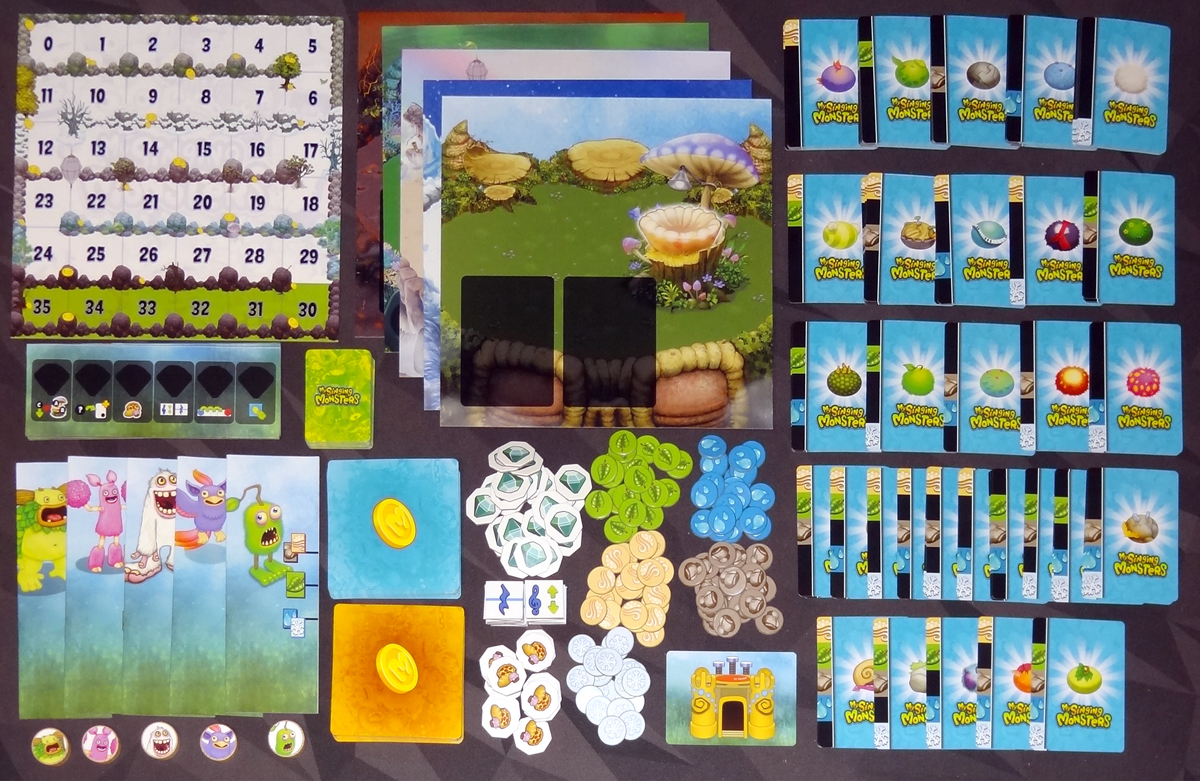
My Singing Monsters: The Board Game Components
Note: My review is based on a prototype copy, so it is subject to change and may not reflect final component quality, though the artwork—which is based on the existing app—looks pretty much finished.
Some of the stretch goals in the campaign will content (like promo cards), and some will upgrade both the standard and deluxe editions. For instance, the first goal (already reached) upgraded the standard edition to acrylic element tokens, while the deluxe (which already included those) have upgraded the other other tokens.
Here’s what comes in the box:
- Score board
- 5 Island boards
- 5 Mini-Mine boards
- 5 Element boards
- 5 Player Score markers
- 35 Decoration cards
- 48 Music cards
- 155 tokens (elements, treats, diamonds, rests/clefs)
- Wubbox card
- 130 Monster cards
The Kickstarter video shows some 3D cardboard components that go with each island board, but these weren’t present in the prototype and I didn’t see them listed in the deluxe edition either, so it’s not clear if those are in the deluxe edition, or if they’re stretch goals that may be added later. The big thing that the deluxe edition will include is painted miniatures of some monsters—these are used on the scoring track instead of the small scoring discs in the regular edition.
The monster cards are standard-sized cards, the decoration cards are half-sized, and the music cards are large squares.
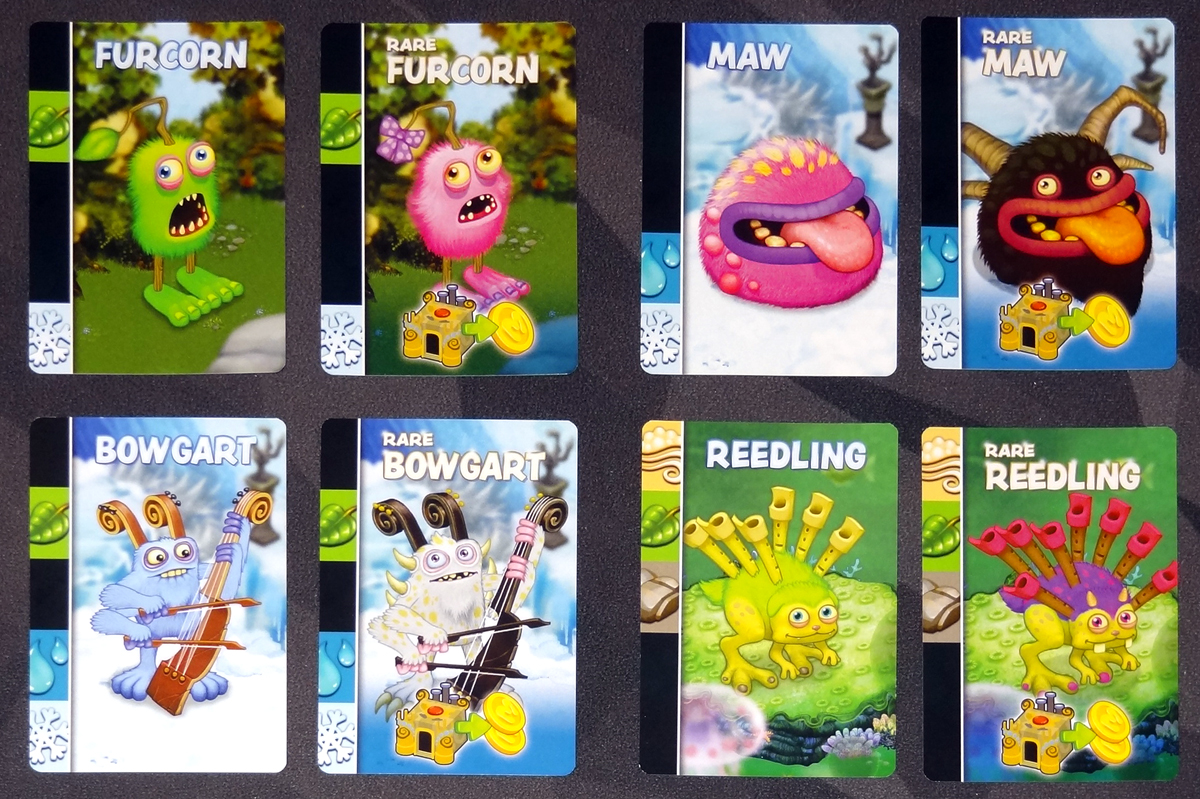
In case you’re not familiar with the app, the theme involves a series of elemental islands (plant, cold, air, water, and earth) that you gradually populate with bizarre musical creatures, each one producing a particular sound. As you accumulate monsters, the sounds layer together, a bit like one of those loop machines, and you can activate or deactivate monsters to choose which sounds to include.
The tabletop game includes monsters from the app (though only a selection of them!). Each monster includes some number of the elements, as shown on the left side of the cards, and as you combine monsters, you can create higher level monsters. There are also “rare” versions of monsters, with special abilities on the cards and increasingly strange appearances. The backs of the cards have a funny “egg” illustration that shares some features with the monster itself.
One thing that’s a little tricky is that there are 30 different types of monsters total, with multiple copies of each one, and you have to have them sorted out so that you can find them during the game. That process can take a while, and at the end of the game you have to organize them again. It made me wish there were a card binder or something where you could just flip through to the monster you’re looking for.

The island boards are large square boards, and each one has two spaces where monster cards can be played. Some of them have areas for additional tokens or cards to be placed. The islands are actually the tops of giant monsters: if you look at the picture above, you can see a nose and closed eyes at the bottom of each board. The boards are fun to look at, but—aside from the second island that has some cards on it—you don’t actually need that much space on the boards themselves for the gameplay, so it takes up quite a bit of space on the table when you get to the full setup.
Overall, since the illustrations are based on the app, they do a good job of putting you in the world of the app. For those new to the world of My Singing Monsters, it’s a wacky-looking place with a lot of bits inspired by music and instruments, and is a lot of fun to look at.

How to Play My Singing Monsters: The Board Game
The Goal
The goal of the game is to earn the most coins (points) by performing songs (completing music cards).
Setup
No matter what level you’re playing, every player starts with an element board and a blue music card, placed next to the board so the bars on the staff line up with the elements on the board. The monster cards need to be sorted out—I group them by the number of elements (1–4). You’ll need the score board, the element tokens, the music cards, and the Wubbox card. The scoring tokens go on the 0 space of the score board. Each player also takes 3 single-element monster cards corresponding to the elements shown on their board.
The islands are added in this order, depending on your desired complexity level: plant, cold, air, water, earth. Shuffle one of each single-element monster and place them randomly on each space on the islands, returning the rest to the appropriate monster stacks. Each island may include some addition setup instructions.
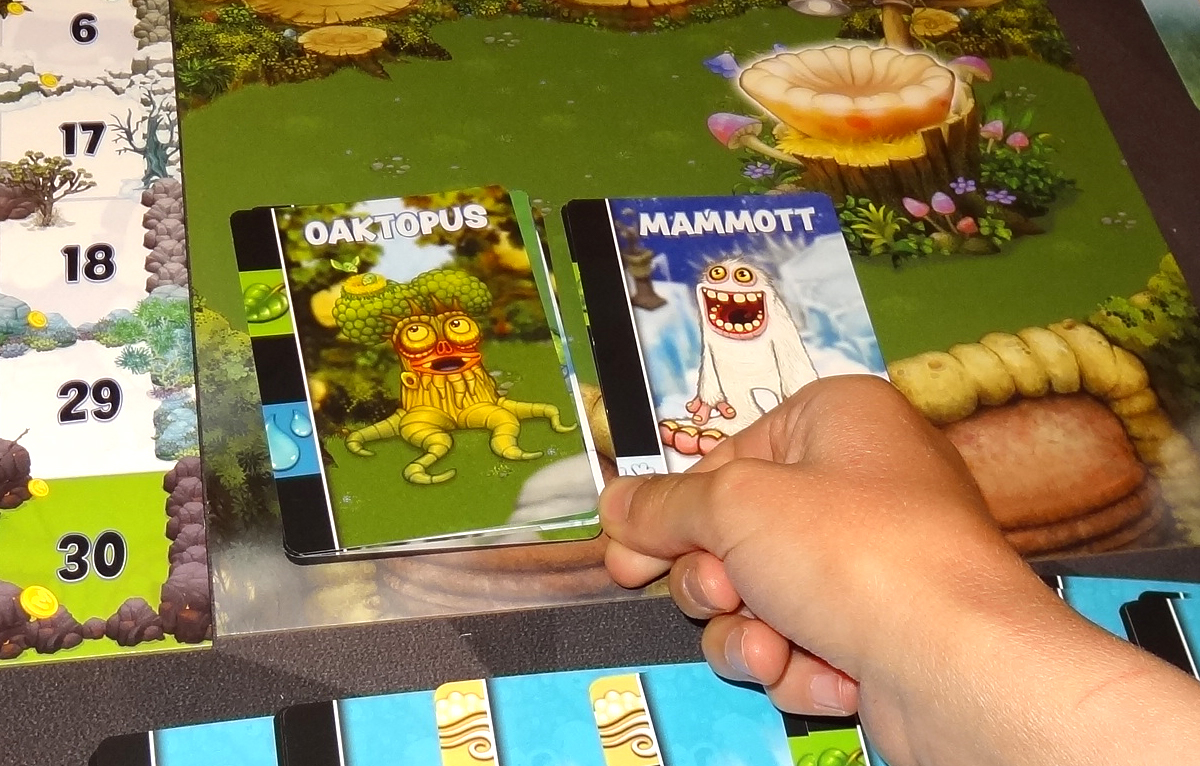
Gameplay
On your turn, you play a card from your hand to an island, and then collect the elements shown on the card you just played, placing them in matching spaces on your music card. If you have elements that can’t be played, they go into the Nursery on Plant Island.
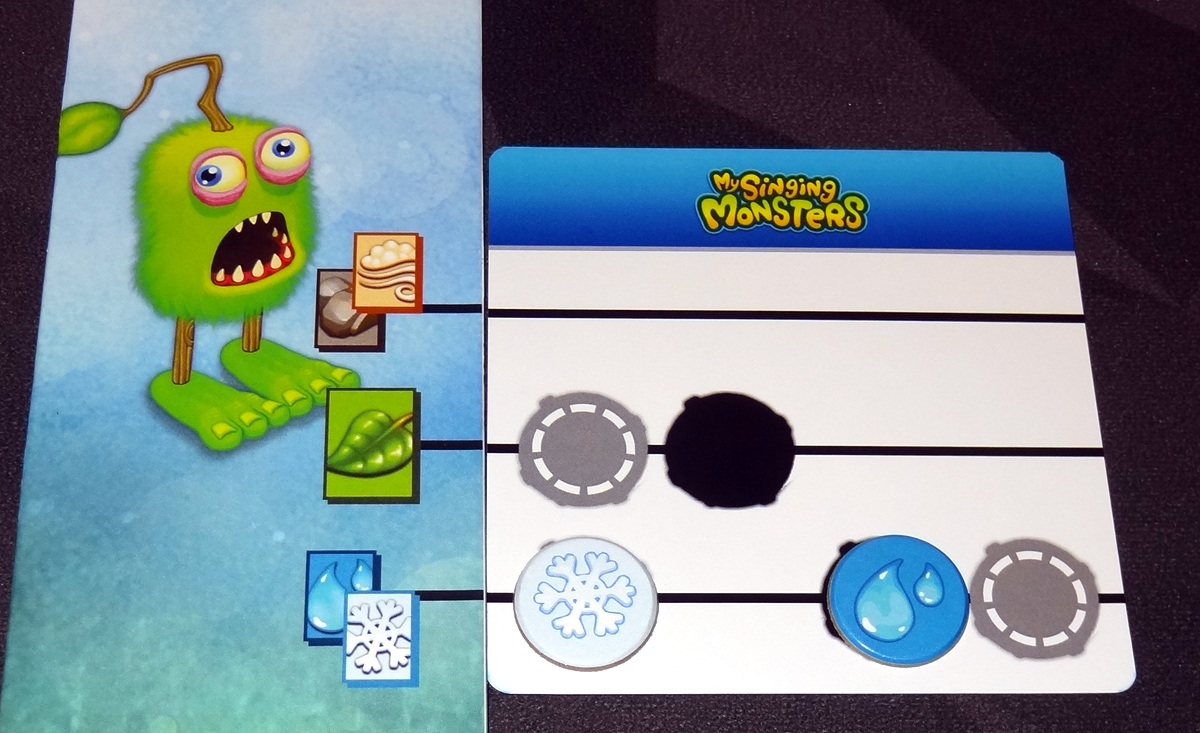
Then, you check the two monster cards now present on the island: if the two monsters do not share any elements in common, then you get to breed a new monster! Take any monster card from the supply that includes only elements shown on the cards on the island (at least one element from each monster). At the end of your turn, if you have fewer than 3 cards, then you draw single-element monsters until you have 3 cards total.
You may also activate the island you played a card to; each island has its own ability, which I’ll explain below.
Finally, there are number of optional actions: if you have a rare or epic monster card, you may feed it to the Wubbox (discarding it) to gain coins or pull other players toward you on the scoring track.

If your music card is complete, you may score it and draw a new music card. Black notes are required to be filled before you can score; grey notes are bonuses. You score one point for each note filled. If you filled all of the notes, you flip the card over and keep it as a coin that may be spent at any time. Otherwise, the music card is discarded.
Note that in the white areas of the score board, no players may share a space (except the 0), so if you land on another player, you skip ahead to the next available space. Your saved coins may be spent by discarding the card and moving forward one space on the track.
Here are the island abilities; some of the islands also introduce other optional actions that may be taken during your turn.
Level 1: Plant Island has a Nursery where unused tokens are placed; if you play a card to Plant Island, you may take any number of elements from the Nursery to play on your music card.

Level 2: Cold Island has decoration cards—these are placed in front of you, and cost 1 coin per decoration card you already own. (Just move backward on the score board when you spend coins.) Decoration cards have various triggers, usually based on somebody else’s action, that will allow you to take a particular element and store it on the decoration. You may move them to your music card as a free optional action during your turn.
Also, for Level 2, you also introduce the advanced music cards, which have more notes to fill. When drawing a new music card, you may choose which type to take.
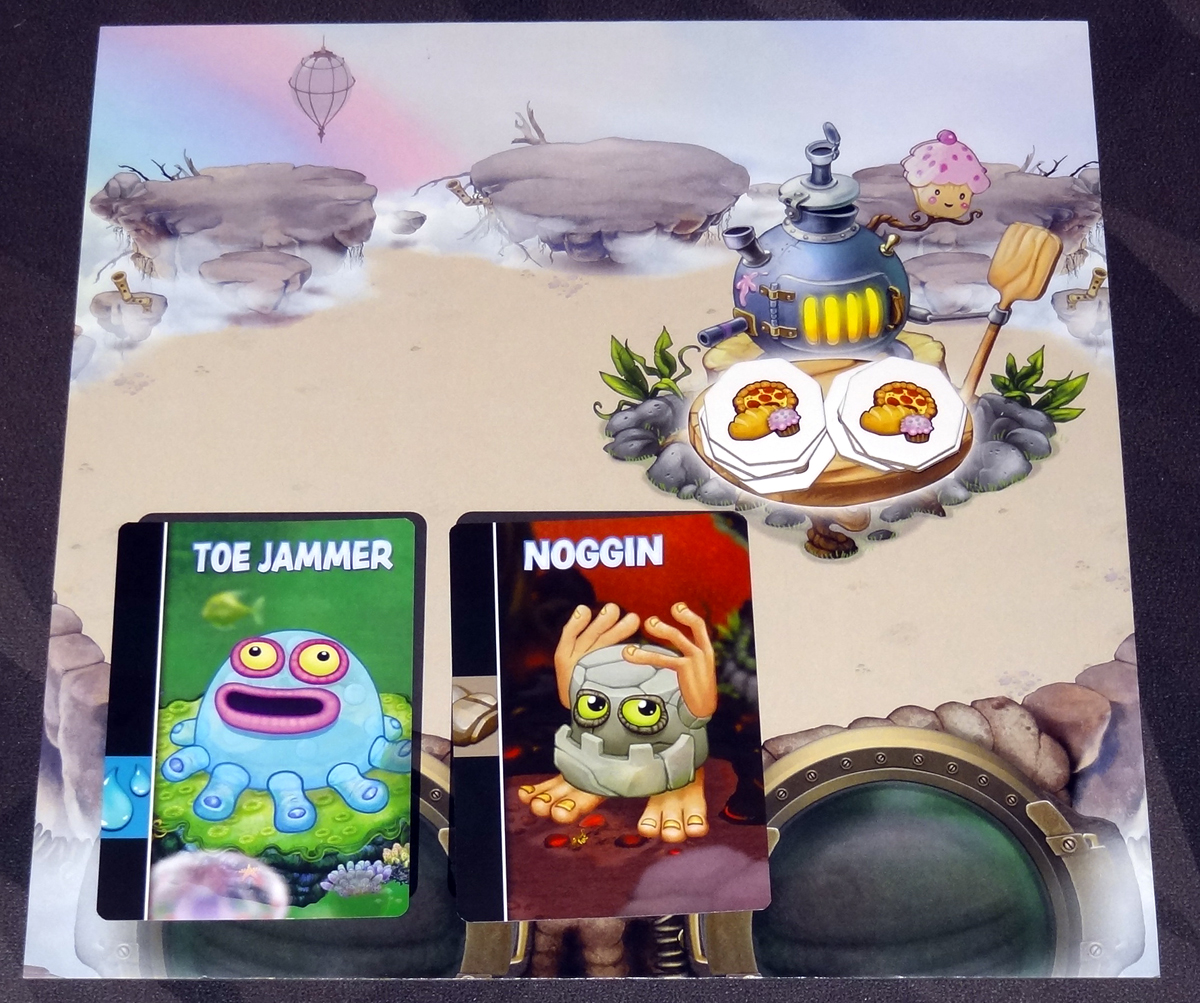
Level 3: Air Island has treat tokens. When you play a card here, you may take a token, which may be spent in the future to duplicate an element from your monster card when collecting.

Level 3 also introduces the advanced element strip. Instead of having 3 lines (two with two elements each), you have a staff with 5 lines. When you place a music card, you may decide where to place it on the staff.

Level 4: Water Island has rest/clef tokens, which you take when you play a card here. The tokens are double-sided and may be spent for either use. A rest may be placed on your music card to cover up a black note so you don’t need to fill it (but will also not get a point for that space). A clef may be discarded to shift your music card up or down, which changes the elements required to fill it.
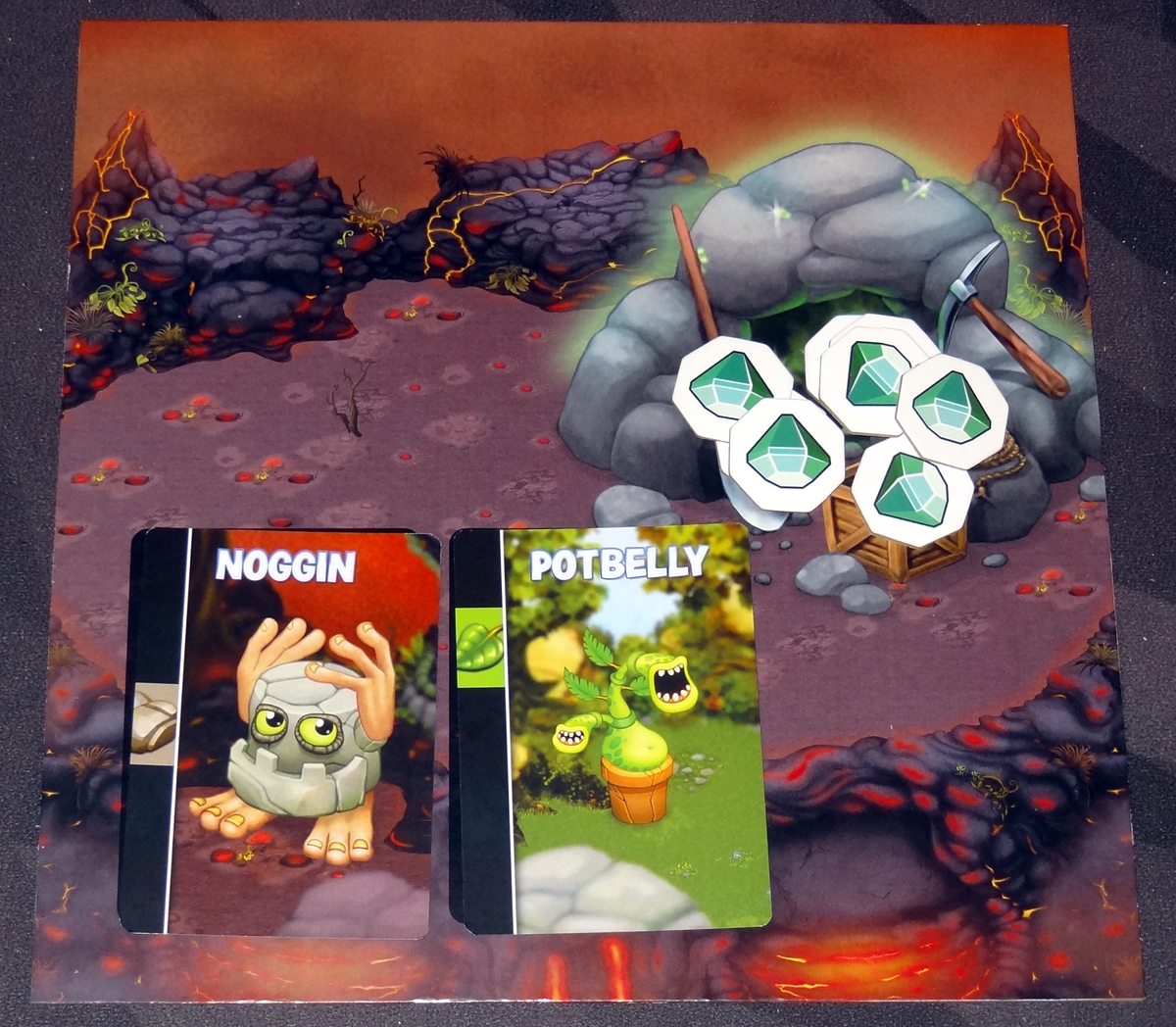
Level 5: Earth Island has a diamond mine. Each time you play a card here, you get to take a diamond and place it on your mini-mine board to get a bonus. Each space on your mini-mine may be used once during the game.

The five effects of the mini-mine board are:
- Take an element token not present in the Nursery and add it to your music card.
- Fill all of your empty decoration cards.
- Duplicate one element from the card you played this turn.
- Shift your music card up or down, or place a rest token on your music card.
- If you’re not the leader on the score board, move yourself up to 3 spaces toward the next closest player ahead of you.
- Gain 1 music card, placed face-down as a coin.
Game End
When a player reaches the green area of the score board, everyone else will get one more turn, and then the game ends. In the green zone, players may end on the same space as other players, but the player who arrived there first wins the tie. The player with the highest score wins!
Why You Should Play My Singing Monsters: The Board Game
I remember when the My Singing Monsters app was released, nearly a decade ago(!). I played with it a little but my kids never really got into it, though I did think the loop-machine effect was somewhat fun to play with. My older kids weren’t as interested in playing a board game (though my 14-year-old did remember the app). My youngest (age 8) had never actually seen the app herself, so for her this was an entirely new world.
So, for me, the theme of the game was something of a curiosity but not necessarily a selling point. I imagine the intended target audience is probably fans of the app, especially given the $10k pledge tier that includes an expenses-paid trip to Big Blue Bubble to design a new mythical monster! That’s not a reward that you’d spring for if all you knew of My Singing Monsters was this board game version. For me, one of the things that drew me to the game was the designers: Sen-Foong Lim and Jay Cormier have collaborated on many games together, including developing games for existing IP like Scooby-Doo, Men in Black, The Shining, and (more recently) Mind MGMT. I was curious to see what they came up with for this app. I’ll note, for fans of the app, that the gameplay isn’t intended to be a translation of the app itself into a game, but rather a tabletop game set in that world.

That said, the wacky monsters are a lot of the appeal. My daughter and I loved flipping over a newly bred monster to see what it actually looked like, and it was fun comparing the regular versions of the monsters with the rare or epic versions. The one thing missing from the tabletop version, of course, is the sounds: fans of the app will probably recognize the creatures and be able to make the right noises.
So, what about the gameplay itself?
The core idea—play cards to gain elements to fill out your music card—is pretty simple, and when you first start at Level 1, it’s easy to pick up. Ideally you want to play cards that let you breed a new monster, because the more elements are on the monster, the more tokens you collect for your music card, and the faster (and more) you can score. But as players gain higher level monsters, it becomes harder to breed, because it’s more likely that there’s an overlap between the card you have and the monsters already present. It’s possible to block another player from breeding, depending on what card you play—and the fewer islands there are, the easier it is to get blocked like that.
You’re allowed to take a monster that has fewer elements than the total number between the two breeding monsters. While that means collecting fewer elements, sometimes there may be some you don’t need for your music card anyway, and that could make it possible to breed on your next turn.
But, of course, you probably don’t want to stay on just Level 1 forever, and that’s one of the cool things about this design: as players get comfortable with the rules, you can gradually add in more islands, pausing when you reach a complexity level that feels like the right amount. Personally, I think adding in the advanced music cards (Level 2) and the advanced element strips (Level 3) give some more flexibility for the players to be able to react to which monsters are currently on the island and which elements seem to be more abundant.

So far, though, my daughter and I have just played the first two levels, which has been fun, but I’m personally interested in adding a bit more complexity to it. The decoration cards (from Level 2) will also get more interesting as additional levels are added, because not all the cards are used at first. I like the way that these will give you elements when other players take certain actions—and that means that once they’re in play, you have to think a little more about what other players may gain from your own choices.
I’m not entirely sure whether the game would have a huge appeal to players who aren’t familiar with the app. It’s a fun world, but also kind of nonsensical, and the game doesn’t necessarily explain what’s going on. For them, I’d say it’s a combination of resource management and set collection, and also has the feel of a worker placement game since the island you pick will give you a particular ability. Keep an eye out for Jenn Mac’s write-up on GeekMom—she’ll be approaching it from the perspective of a kid who’s a superfan of the app, and I’m curious to see what her kid thinks of the game, too.
Overall, I think My Singing Monsters: The Board Game does a pretty good job of building the world of the monsters as a tabletop game, albeit one in which you’ll have to provide your own soundtrack. I think it does have interesting gameplay for those new to the franchise (especially kids like mine who will delight in the strangeness of the illustrations), but will probably hold the most appeal for those who already love the app.
For more information or to make a pledge, visit the My Singing Monsters: The Board Game Kickstarter page!
Click here to see all our tabletop game reviews.
![]() To subscribe to GeekDad’s tabletop gaming coverage, please copy this link and add it to your RSS reader.
To subscribe to GeekDad’s tabletop gaming coverage, please copy this link and add it to your RSS reader.
Disclosure: GeekDad received a prototype of this game for review purposes.
Click through to read all of "Kickstarter Tabletop Alert: ‘My Singing Monsters: The Board Game’" at GeekDad.If you value content from GeekDad, please support us via Patreon or use this link to shop at Amazon. Thanks!

